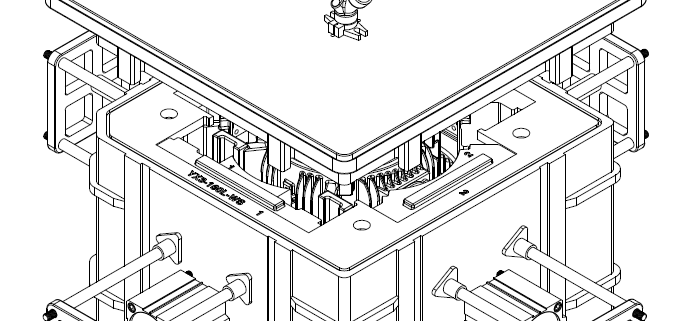Casting is the process of casting a liquid metal into a casting cavity that conforms to the shape of the part. After cooling and solidifying, a forming method of the metal part blank having a certain shape, size and performance is obtained.
Casting is mainly divided into sand casting, low pressure casting, centrifugal casting, metal casting, vacuum casting, extrusion casting, lost foam casting, continuous casting and other eight types. Let us take a look at the respective processes and characteristics of these castings.
(1) Sand casting
Sand casting is a casting method for producing castings in a sand mold. Steel, iron and most non-ferrous alloy castings can be obtained by sand casting.
Process flow
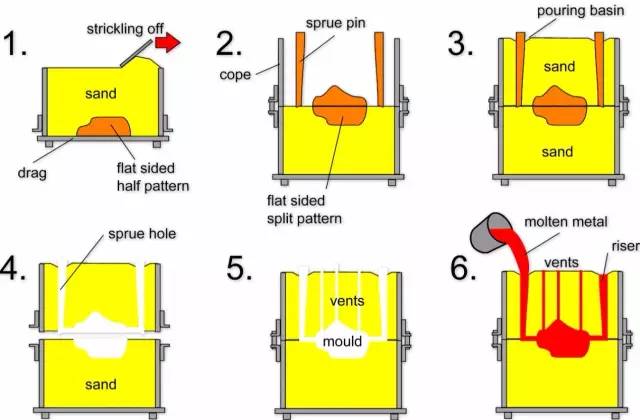
Technical features
1. Suitable for making complex shapes, especially blanks with complex internal cavities;
2. Wide adaptability and low cost;
3. For some materials with poor plasticity, such as cast iron, sand casting is the forming process for manufacturing parts or blanks.
Application: Castings for engine cylinder block, cylinder head, crankshaft, etc.
(2) Low pressure casting
Low-pressure casting: refers to a method in which a liquid metal is filled under a lower pressure (0.02 to 0.06 MPa) and crystallized under pressure to form a casting.
Process flow
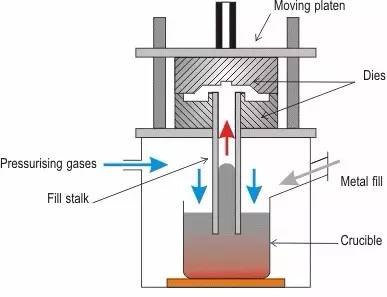
Technical features
1. The pressure and speed during pouring can be adjusted, so it can be applied to various casting types (such as metal type, sand type, etc.), casting various alloys and various sizes of castings;
2. Using the bottom injection type filling, the metal liquid filling type is stable, no splash phenomenon, can avoid the entrapment of gas and the erosion of the wall and the core, and improve the pass rate of the casting;
3. The casting is crystallized under pressure. The casting has compact structure, clear outline, smooth surface and high mechanical properties, which is especially beneficial for the casting of large thin-walled parts;
4. Eliminating the need to replenish the riser, the metal utilization rate increased to 90 ~ 98%;
5. Low labor intensity, good working conditions, simple equipment, easy to achieve mechanization and automation.
Application: Mainly based on traditional products (cylinder head, wheel hub, cylinder block, etc.).
(3) Centrifugal casting
Centrifugal casting: A casting method in which a molten metal is poured into a rotating mold and filled with a mold under centrifugal force to solidify and form.
Process flow
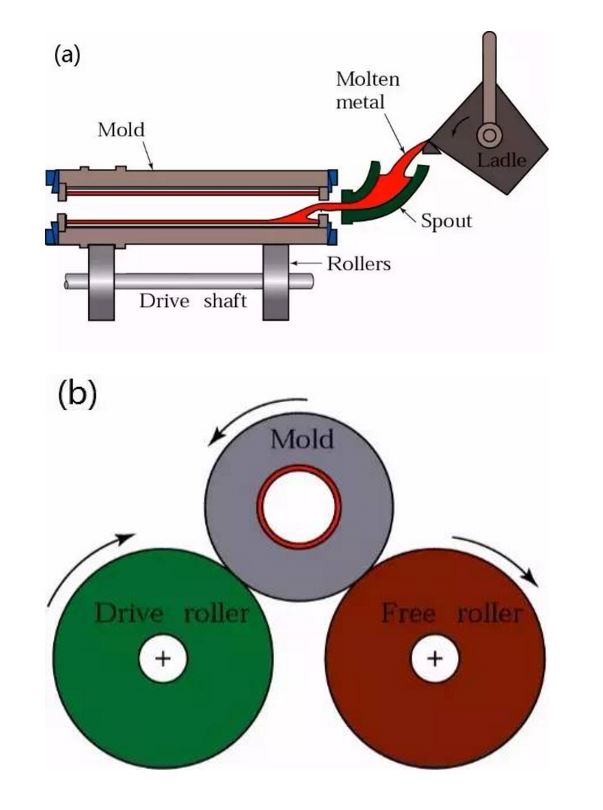
Process characteristics
Advantage:
1. There is almost no metal consumption of the gating system and the riser system, which improves the process yield;
2. The core can be used in the production of hollow castings, so the metal filling ability can be greatly improved when producing long tubular castings;
3. The casting has high density, less defects such as pores and slag inclusion, and high mechanical properties;
4, easy to manufacture cylinders, sets of composite metal castings.
Disadvantages:
1. There are certain limitations when used to produce shaped castings;
2. The diameter of the inner hole of the casting is not accurate, the surface of the inner hole is rough, the quality is poor, and the machining allowance is large;
3. Castings are prone to segregation of specific gravity.
Application: Centrifugal casting is used to produce cast pipes earlier. At home and abroad, centrifugal casting processes are used in metallurgy, mining, transportation, irrigation and drainage machinery, aviation, national defense, automotive and other industries to produce steel, iron and non-ferrous carbon alloy castings. Among them, the production of castings such as centrifugal cast iron pipes, internal combustion engine cylinder liners and bushings is more common.
(4) Gravity die casting
Metal casting: refers to a molding method in which a liquid metal is filled with a metal mold under the action of gravity and cooled and solidified in a mold to obtain a casting.
Process flow
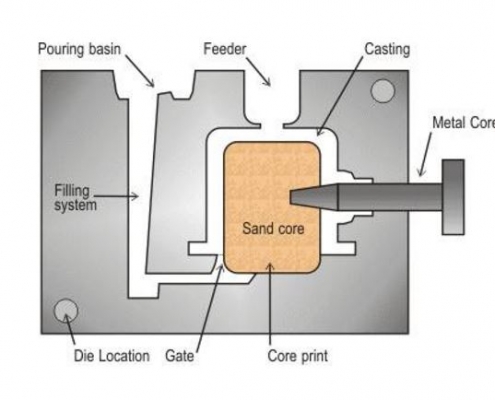
Process characteristics
Advantage:
1. The thermal conductivity and heat capacity of the metal type are large, the cooling rate is fast, the casting structure is dense, and the mechanical properties are about 15% higher than the sand casting.
2. It can obtain castings with higher dimensional accuracy and lower surface roughness, and has good quality stability.
3, because of the use and rarely use sand core, improve the environment, reduce dust and harmful gases, reduce labor intensity.
Disadvantages:
1. The metal type itself has no gas permeability, and certain measures must be taken to derive the air generated by the cavity and the gas generated by the sand core;
2. The metal type has no repellent property, and the casting is prone to crack when solidified;
3. The metal type has a long manufacturing cycle and high cost. Therefore, only when a large number of batch production, can show good economic results.
Application: Metal casting is suitable for mass production of non-ferrous alloy castings such as aluminum alloys and magnesium alloys with complex shapes, as well as castings and ingots for the production of steel and metal.
(5) Vacuum die casting
Vacuum casting: An advanced die-casting process that improves the mechanical properties and surface quality of die-casting parts by removing or removing the pores and dissolved gases in the die-casting part by removing the gas in the cavity of the die-casting mold during the die-casting process.
Process flow
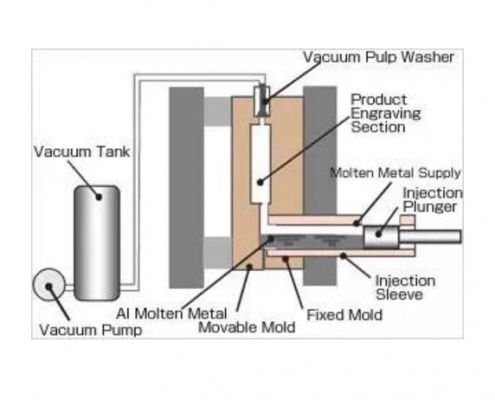
Process characteristics
Advantage:
1. Eliminate or reduce the air holes inside the die-casting parts, improve the mechanical properties and surface quality of the die-casting parts, and improve the plating performance;
2, reduce the back pressure of the cavity, you can use a lower specific pressure and alloy with poor casting properties, it is possible to die cast large castings with a small machine;
3. Improve the filling conditions and die-cast thinner castings;
Disadvantages:
1. The mold sealing structure is complicated, and the manufacturing and installation are difficult, so the cost is high;
2. If the vacuum die casting method is not properly controlled, the effect is not very significant.
(6) Squeezing die casting
Squeeze casting: A method in which a liquid or semi-solid metal is solidified and flow-formed under high pressure to directly obtain a part or a blank. It has the advantages of high utilization rate of liquid metal, simplified process and stable quality. It is an energy-saving metal forming technology with potential application prospects.
Process flow
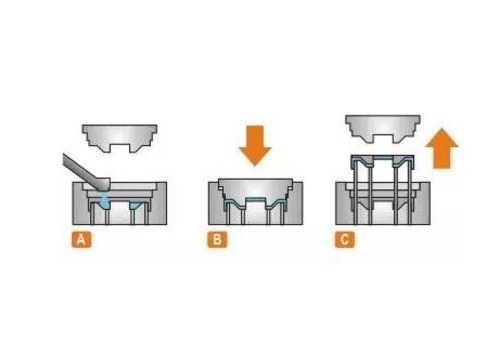
Direct extrusion casting: spray coating, alloy casting, mold clamping, pressurization, pressure holding, pressure relief, parting, blank demoulding, resetting;
Indirect extrusion casting: spray coating, mold clamping, feeding, filling, pressing, holding pressure, pressure relief, parting, blank demoulding, resetting.
Technical features
1. It can eliminate defects such as internal pores, shrinkage holes and shrinkage;
2. Low surface roughness and high dimensional accuracy;
3, can prevent the occurrence of casting cracks;
4. It is easy to realize mechanization and automation.
Application: Can be used to produce various types of alloys, such as aluminum alloy, zinc alloy, copper alloy, ductile iron, etc.
(7) Lost foam casting
Lost Foam Casting (also known as solid casting): It is a combination of paraffin or foam model similar in shape and shape of casting into a model cluster, brushed with refractory paint and dried, buried in dry quartz sand for vibration modeling, in negative The new casting method of casting is carried out by pressing down the casting to vaporize the model, occupying the position of the liquid metal, and solidifying and cooling.
Process: pre-expansion→foaming molding→dipping coating→drying→styling→casting→falling sand→cleaning
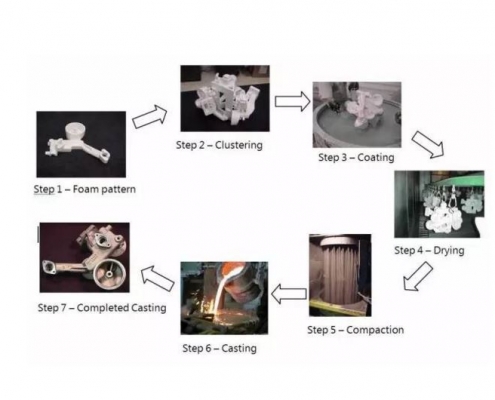
Technical features
1. The casting has high precision and no sand core, which reduces the processing time;
2. No parting surface, flexible design, high degree of freedom;
3. Clean production, no pollution;
4. Reduce investment and production costs.
Application: It is suitable for various types of precision castings with complex structure. The alloy type is not limited, and the production batch is not limited. Such as gray cast iron engine box, high manganese steel elbow and so on.
(8)Continuous casting
Continuous casting: an advanced casting method, the principle is to continuously cast molten metal into a special metal type called crystallizer, solidify (crusted) castings, continuously from the crystallizer Pull out at one end to obtain castings of any length or length.
Process flow
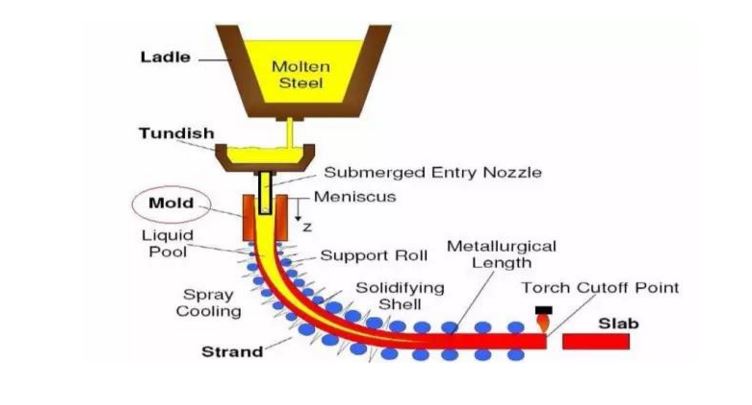
Technical features
1. Since the metal is rapidly cooled, the crystal is dense, the structure is uniform, and the mechanical properties are good;
2. Save metals and increase the yield;
3. Simplified the process, eliminating the shape and other processes, thus reducing the labor intensity; the required production area is also greatly reduced;
4. Continuous casting production is easy to realize mechanization and automation, and improve production efficiency.
Application: Continuous casting can be used to cast long castings with constant cross-section such as steel, iron, copper alloy, aluminum alloy and magnesium alloy, such as ingots, slabs, billets, tubes, etc.

